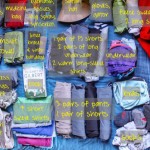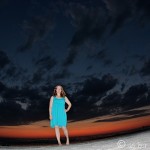Are you curious what I packed in my suitcase for nine months of travel?
Well, me too! I was so rushed when I first departed for my trip in March 2013 that I didn’t have time to document what items made the cut. Then once I was on the road, everything found a home in the various nooks of my luggage so it wasn’t until month seven — in Nepal — that I had a free evening and space to properly record all the stuff I carry with me. People often ask what I pack for long-term travel and now I finally have a concrete answer.
Here’s the whole shebang:

And here’s a notated version, since it’s hard to see everything:
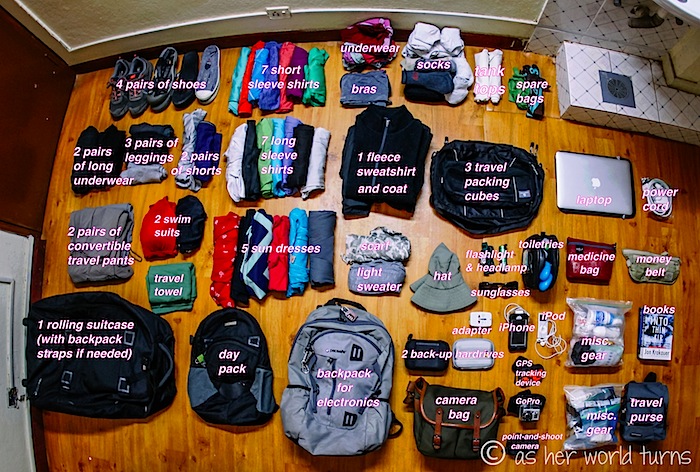
I’ll start off by saying I WAY over-packed for this trip. I’m currently traveling for four months in Africa with so much less that I can even fit a sleeping bag inside my rolling suitcase, something I never could’ve packed on my RTW trip since my bags were already stretched to the max.

Since I knew I would be in both warm and cold climates, I packed an even mix of short sleeve and long sleeve shirts — seven of each. (In retrospect I would’ve taken five short sleeve and two long sleeve.) Every single one is dry-fit so that it can be easily hand-washed to dry overnight.
I also brought five sun dresses. That sound you hear is my palm hitting my forehead — what was I thinking?! I only wore them a handful of times over nine months, like when I went to the Sydney Opera House or out to dinner when my uncle visited me in Israel and Turkey. One of the colorful ones would’ve been enough, plus the plain grey one because it doubles as a swim suit cover-up.

Perhaps the most crucial clothing decision was to bring two pairs of convertible travel pants. Like my shirts, they dry quickly if I wash them overnight. They zip off just below the knee to become capris, which is really handy when traveling through different climates. I bought these two pairs for around $75 each at REI five years ago and they’ve held up well; only recently have I had to use a needle and thread for minor repairs where some seems have come loose. (The brands are Mountain Hardwear Yuma pants — this new model doesn’t zip off at the knees — and a pair of Prana pants.)
I also brought four pairs of leggings (totally unnecessary, as they were intended to match the sun dresses I rarely wore), plus two pairs of shorts and two pairs of long underwear. I picked up another pair of long underwear in Kathmandu just prior to hiking Mt. Everest Base Camp.
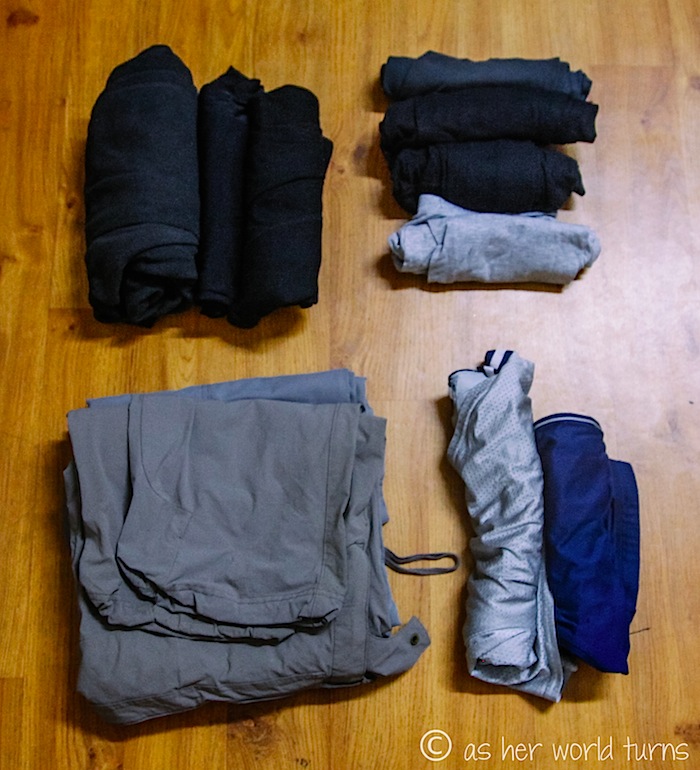
Since I have no shame, here are my undergarments. I brought all sports bras and underwear specifically made for travel (the brand is ExOfficio) — meaning it’s quick-drying for when I do laundry in a sink, plus it’s extremely comfortable. Initially I only brought a few pairs of socks with me, but picked up a lot more at Target in Australia. Then I bought trekking socks in Kathmandu for Everest Base Camp. I never wore the tank tops.
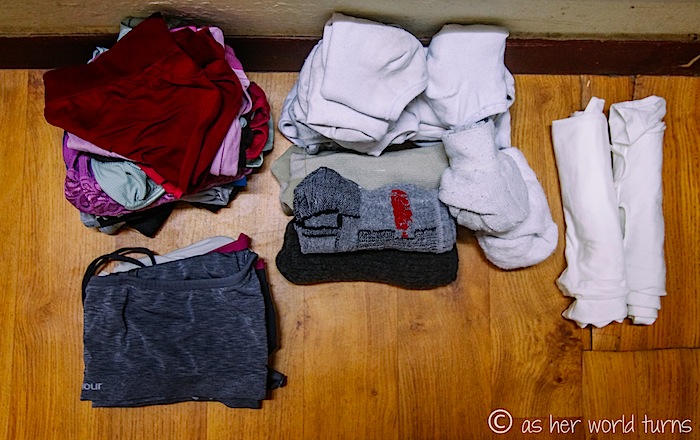
I brought one fleece sweatshirt and my favorite coat from Scottevest, a company that makes travel-friendly clothes with extra pockets and security features. I contacted them before my trip and they very kindly sent me the Molly Jacket. I’ve put it through the ringer — like wearing it in sulfur mines in Indonesia; thankfully the smell came out — and it’s held up so well over the past 1.5 years of travel. Recently I visited Ethiopia and I didn’t feel safe carrying my purse outside after dark. This coat came to the rescue, holding all of the items I would’ve otherwise put in a purse, but instead they were strapped securely inside my jacket (including bulky items like a book, bottle of water, wallet, and travel umbrella).
Here I am wearing my Scottevest jacket around the world:
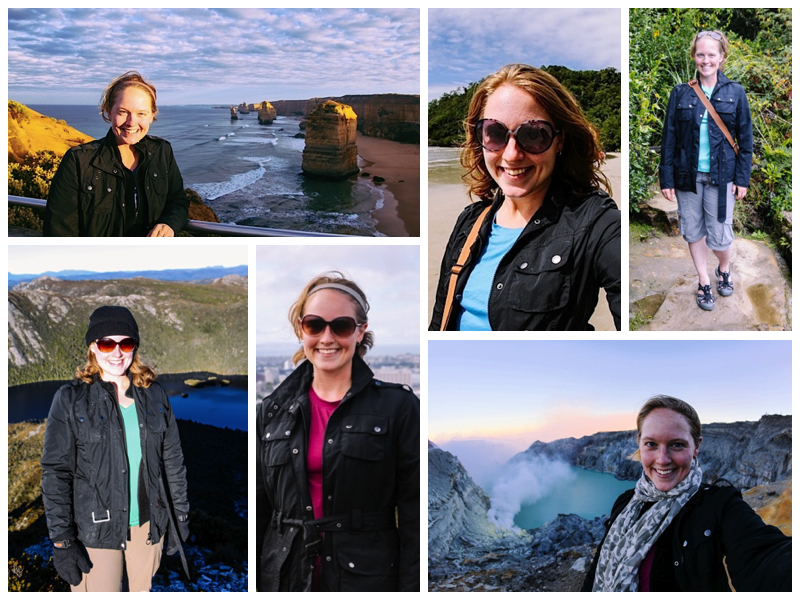
Aside from the fleece and Scottevest coat, a few other items include a headlamp and flashlight, sunglasses, a wide-brimmed hat that folds down small, and a scarf and light sweater.

I brought two swim suits, which might sound unnecessary but both proved useful. I spent a good deal of time in warm weather on this trip and it was nice to rotate between two suits, especially when scuba diving. For my current Africa travels, I only brought one because there are less opportunities to swim and scuba dive now.
I used this fast-drying travel towel that I’ve owned for years, originally purchased at REI. It is the most durable towel imaginable and I’m embarrassed to tell you how long I go without washing it, because it dries odorless and feels like new every time.

I brought four pairs of shoes and all proved essential.
Every day, I wore either my sneakers or Keen sandals depending on the climate. I even wore those sneakers for all 12 days of hiking to Everest Base Camp, which I wouldn’t recommend, but they worked for me. The Keen sandals are perfect for warmer climates — I wear them every day in Africa — but they smell terrible after constant use. I remember buying baking soda and vinegar in Bali to soak them for a few hours; it sort of worked. Nowadays I wash my feet a few times a day or just wear socks with them — admittedly, it’s not a fashion-forward look, but it helps prevent mosquito bites in malaria-land.
I typically wore the basic black flip flops each night at the hostel. It’s so nice to slip into something more comfortable after a day in other shoes, plus they’re great for showering and the beach.
Lastly, I packed cheap slip-on shoes, which I wore the few times I donned a sun dress. They’re not fancy by any means, but they look better than the other pairs I own and they take up almost no room in my bag. My friend Melanie borrowed them to hike Mujib Canyon in Jordan and I tossed them after that — the nice thing about $5 shoes is there’s no guilt in trashing them when the time comes.

About 75% of my belongings fit inside this 75 liter rolling bag: the Caribee Fast Track 75 (there are a few posted on Amazon so look around before purchasing for the best price). It also has backpack straps which I’ve never used. I bought it on-line for around $150 just before I left on my trip and I’m very pleased with it. It came with that small day pack in the center of the photo below, which has been handy on a number of occasions; it rolls up quite small when I don’t need it.
My electronics backpack is made by Pacsafe and I bought it for around $100 a few years ago before going to Hawaii (Pacsafe Luggage Venturesafe 25l Daypack, currently unavailable on Amazon). It has metal meshing under the fabric to prevent a would-be thief from slashing it open. Nowadays it’s looking a little worse for wear, but it’s held up remarkably well considering I carry it every single day. It holds my laptop, power cord, adapters, small cameras (point-and-shoot, underwater, GoPro), plus their battery chargers.
My primary camera bag is from Moshithings (around $100) and it’s served me well over the past 1.5 years. It was a gift from several generous Y&R co-workers and I think of them all the time when I use it. It holds my bulky 5D Mark ii camera body plus two lenses, my wallet, passport, sunscreen, hand sanitizer, spare battery & memory card, notebook, USB cable, chapstick, and emergency poncho. It’s more like a purse / camera bag combo and I take it everywhere with me.
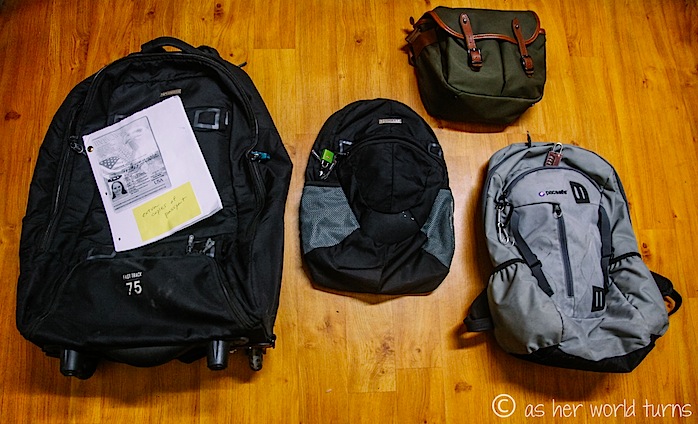
I use these packing cubes from eBags to separate my shirts, pants, socks, etc. so that items are easier to find. I also have two spare bags — a RISD tote bag from my sister and a durable fold-up green bag from my Y&R co-worker Vanessa. When I go on smaller trips and leave my big bag behind, I just take these two totes for essential items like clothes and toiletries (I just did this two weeks ago for both the Serengeti and Zanzibar, which were each 3-day trips).

Other items that made the cut: my money belt, a homemade medical kit, toiletries, a few paperback books, and mini notebooks. Oh, and travel locks, which aren’t shown here but are invaluable (I go with the combination lock over the one with a key, as it’s always a pain to search for the key).
My medical kit contains anything I might need — mostly over-the-counter meds, plus a few more my travel doctor prescribed before the trip. The common meds I find most helpful are sleep aids like Ibprofin PM or Tylenol PM; even a single pill helps me rest better when I’m in an unfamiliar environment or noisy hostel. Other meds include Pepto bismol tablets, water purification tablets, allergy meds, Sudafed, Immodium AD, antihistamine, Ibprofin, and cough drops. The prescription items I carry are anti-malarial meds (doxycycline for this trip although I usually prefer Malarone), Azithromycin (antibiotics for sinus infections or stomach issues; it fixes a variety of problems), permethrin cream (because I got scabies at the end of my RTW trip last year and now I travel with this cream in case it happens again), and altitude meds for hiking Kilimanjaro (Diamox). Packing tip: I always take the meds out of their containers and put them in small ziplock bags to save space. I cut out the labels from the original packaging and keep them inside the ziplock bag with their respective pills so I can reference directions or active ingredients.
I have travel-size bottles of everything in my toiletry kit (shampoo, conditioner, soap, face wash). While on the road, I purchased full-size bottles of those items to keep in my large rolling bag and then I refilled the travel-size bottles as needed. I did this because I’d rather tote small bottles into hostel showers than the big ones.
I used mini-notebooks to document all of the money I spent while traveling and also to remember the people I met. It’s been so helpful in tracking my spending and also recalling details like names and incidents that might otherwise escape my memory over time. I reference both often while writing this blog, so I can remember how much activities cost or specific details of people I met and photographed.

And now for the electronics list… the area of my luggage I spend the most time obsessing over. Aside from my money belt, all of my valuables are contained in this section and I’m constantly vigilant about locking them up.
My MacBook Air is crucial to what I do and I use it every single day to upload, edit, and manage photos. I’m typing on it right now. If anything happened to it I would be devastated! Other electronics include my iPhone, iPod, GoPro, point-and-shoot camera, underwater camera, GPS tracking device, travel plug converter, and two back-up hard drives where I store all of my images. (I keep each hard drive in a different bag so that if one gets lost or stolen, hopefully the other one will be safe.) As for the GPS tracking device, it’s something my parents paid for because they wanted me to have it. It didn’t prove to be useful because I had to be outside in an open area for it to log my coordinates, so every time I tried it in a hostel the signal failed. I used it for months before realizing this. However, the Viber app on my iPhone (which I use to communicate for free with friends and family back home) has a GPS feature where I can send my exact location. So long as I have a signal or wifi, I can send it from anywhere — no need to be outside in an open field! Granted I sometimes don’t have wifi, but it’s so much more practical than the tracking device.
Other electronics not pictured: the contents of my camera bag, including a camera body and a few lenses.
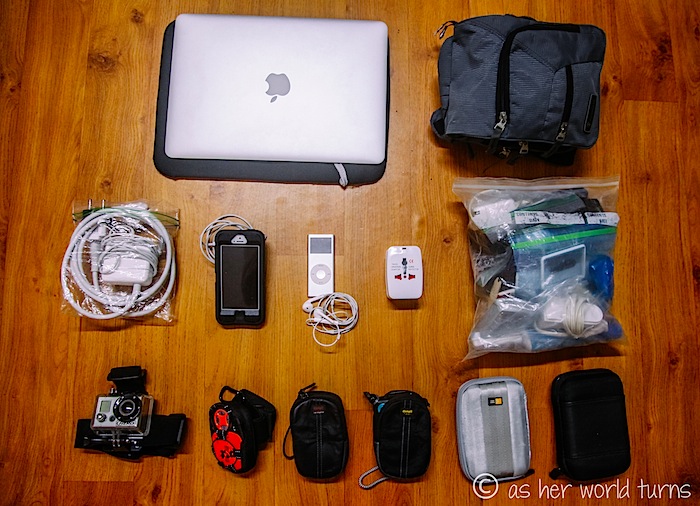
Finally, you may have noticed two large ziplock bags labeled “misc. gear” in the notated photo at the top of this post (one of the bags is shown in the above photo). They hold all the random things that don’t otherwise have a home — spare batteries, extra eye drops, accessories for my GoPro, an electric toothbrush that I should’ve used but never bothered charging, a small roll of duct tape, and more.
One last look at the whole kit and caboodle:
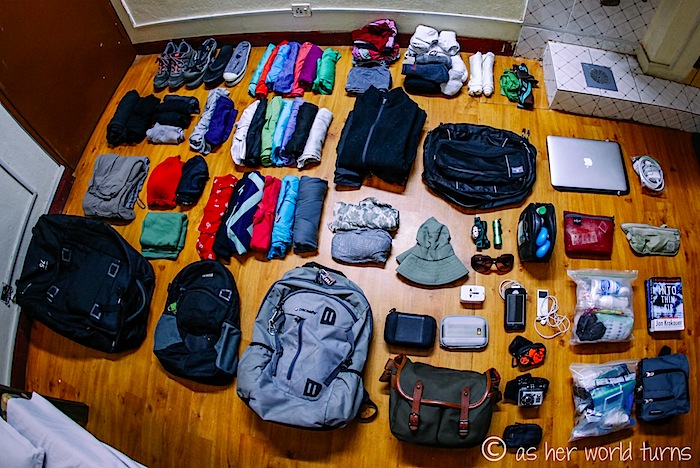
When I get back from Africa I hope to do another post on the evolution of my packing list and how I’ve managed to be more efficient.

